MKTM028 Strategic Marketing: Applying STP with Industry Examples
VerifiedAdded on 2023/06/04
|13
|3073
|307
Essay
AI Summary
This essay provides a comprehensive exploration of Segmentation, Targeting, and Positioning (STP) within the framework of strategic marketing. It delves into the theoretical underpinnings of STP, drawing upon academic literature and marketing strategy concepts. The essay critically evaluates the application of STP by various organizations, using industry examples such as Apple, Tupperware and Nestle to illustrate the practical implementation of these concepts. Furthermore, the analysis extends to offering generic recommendations for companies seeking to leverage STP effectively, highlighting the importance of aligning marketing efforts with customer needs and competitive positioning. The essay concludes by reinforcing the significance of STP as a fundamental tool for achieving marketing success and fostering customer satisfaction.

Student Name
[Course title]
strategic marketing
Institutional Affiliation(S)
[Course title]
strategic marketing
Institutional Affiliation(S)
Paraphrase This Document
Need a fresh take? Get an instant paraphrase of this document with our AI Paraphraser
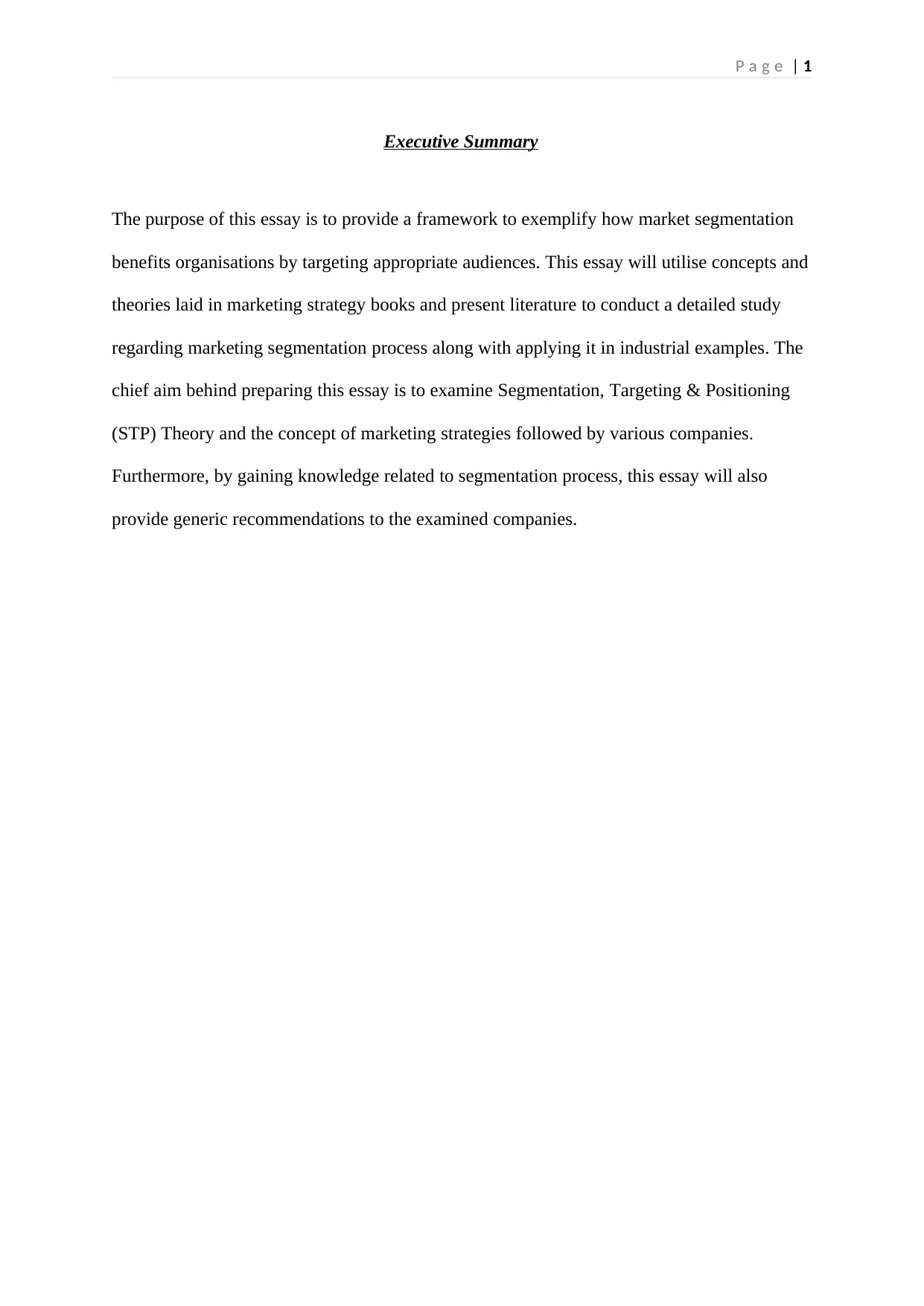
P a g e | 1
Executive Summary
The purpose of this essay is to provide a framework to exemplify how market segmentation
benefits organisations by targeting appropriate audiences. This essay will utilise concepts and
theories laid in marketing strategy books and present literature to conduct a detailed study
regarding marketing segmentation process along with applying it in industrial examples. The
chief aim behind preparing this essay is to examine Segmentation, Targeting & Positioning
(STP) Theory and the concept of marketing strategies followed by various companies.
Furthermore, by gaining knowledge related to segmentation process, this essay will also
provide generic recommendations to the examined companies.
Executive Summary
The purpose of this essay is to provide a framework to exemplify how market segmentation
benefits organisations by targeting appropriate audiences. This essay will utilise concepts and
theories laid in marketing strategy books and present literature to conduct a detailed study
regarding marketing segmentation process along with applying it in industrial examples. The
chief aim behind preparing this essay is to examine Segmentation, Targeting & Positioning
(STP) Theory and the concept of marketing strategies followed by various companies.
Furthermore, by gaining knowledge related to segmentation process, this essay will also
provide generic recommendations to the examined companies.
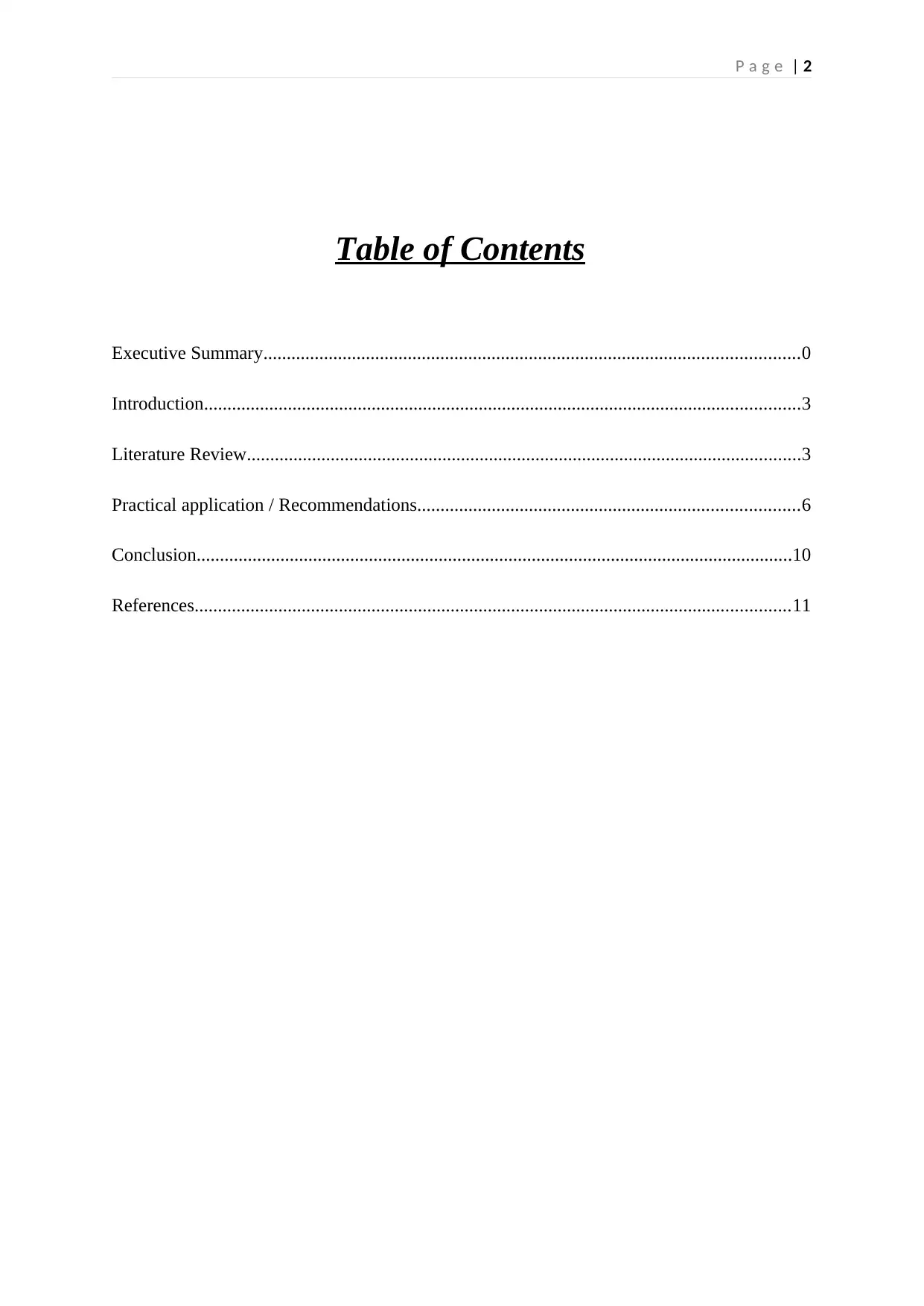
P a g e | 2
Table of Contents
Executive Summary...................................................................................................................0
Introduction................................................................................................................................3
Literature Review.......................................................................................................................3
Practical application / Recommendations..................................................................................6
Conclusion................................................................................................................................10
References................................................................................................................................11
Table of Contents
Executive Summary...................................................................................................................0
Introduction................................................................................................................................3
Literature Review.......................................................................................................................3
Practical application / Recommendations..................................................................................6
Conclusion................................................................................................................................10
References................................................................................................................................11
⊘ This is a preview!⊘
Do you want full access?
Subscribe today to unlock all pages.

Trusted by 1+ million students worldwide
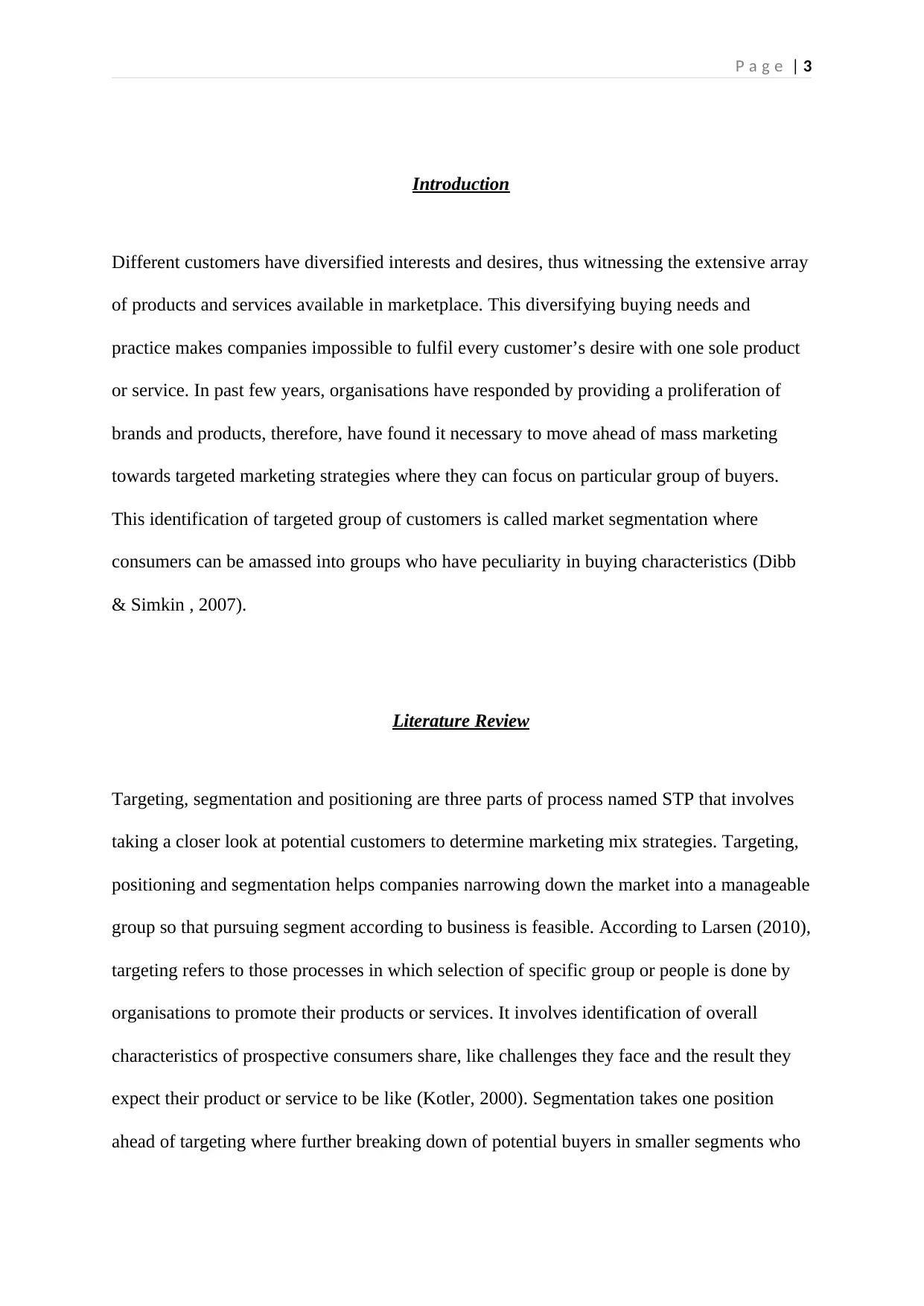
P a g e | 3
Introduction
Different customers have diversified interests and desires, thus witnessing the extensive array
of products and services available in marketplace. This diversifying buying needs and
practice makes companies impossible to fulfil every customer’s desire with one sole product
or service. In past few years, organisations have responded by providing a proliferation of
brands and products, therefore, have found it necessary to move ahead of mass marketing
towards targeted marketing strategies where they can focus on particular group of buyers.
This identification of targeted group of customers is called market segmentation where
consumers can be amassed into groups who have peculiarity in buying characteristics (Dibb
& Simkin , 2007).
Literature Review
Targeting, segmentation and positioning are three parts of process named STP that involves
taking a closer look at potential customers to determine marketing mix strategies. Targeting,
positioning and segmentation helps companies narrowing down the market into a manageable
group so that pursuing segment according to business is feasible. According to Larsen (2010),
targeting refers to those processes in which selection of specific group or people is done by
organisations to promote their products or services. It involves identification of overall
characteristics of prospective consumers share, like challenges they face and the result they
expect their product or service to be like (Kotler, 2000). Segmentation takes one position
ahead of targeting where further breaking down of potential buyers in smaller segments who
Introduction
Different customers have diversified interests and desires, thus witnessing the extensive array
of products and services available in marketplace. This diversifying buying needs and
practice makes companies impossible to fulfil every customer’s desire with one sole product
or service. In past few years, organisations have responded by providing a proliferation of
brands and products, therefore, have found it necessary to move ahead of mass marketing
towards targeted marketing strategies where they can focus on particular group of buyers.
This identification of targeted group of customers is called market segmentation where
consumers can be amassed into groups who have peculiarity in buying characteristics (Dibb
& Simkin , 2007).
Literature Review
Targeting, segmentation and positioning are three parts of process named STP that involves
taking a closer look at potential customers to determine marketing mix strategies. Targeting,
positioning and segmentation helps companies narrowing down the market into a manageable
group so that pursuing segment according to business is feasible. According to Larsen (2010),
targeting refers to those processes in which selection of specific group or people is done by
organisations to promote their products or services. It involves identification of overall
characteristics of prospective consumers share, like challenges they face and the result they
expect their product or service to be like (Kotler, 2000). Segmentation takes one position
ahead of targeting where further breaking down of potential buyers in smaller segments who
Paraphrase This Document
Need a fresh take? Get an instant paraphrase of this document with our AI Paraphraser
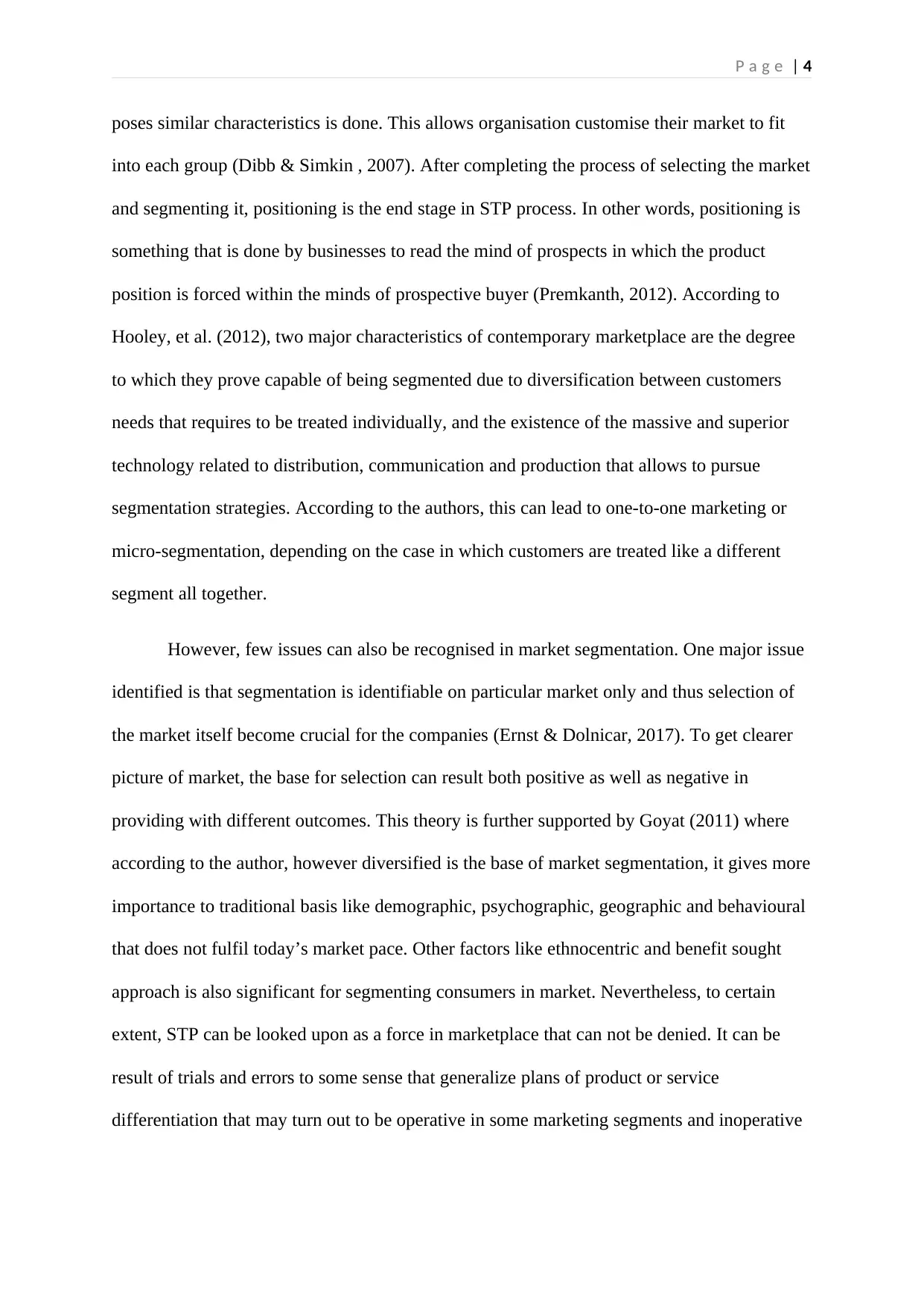
P a g e | 4
poses similar characteristics is done. This allows organisation customise their market to fit
into each group (Dibb & Simkin , 2007). After completing the process of selecting the market
and segmenting it, positioning is the end stage in STP process. In other words, positioning is
something that is done by businesses to read the mind of prospects in which the product
position is forced within the minds of prospective buyer (Premkanth, 2012). According to
Hooley, et al. (2012), two major characteristics of contemporary marketplace are the degree
to which they prove capable of being segmented due to diversification between customers
needs that requires to be treated individually, and the existence of the massive and superior
technology related to distribution, communication and production that allows to pursue
segmentation strategies. According to the authors, this can lead to one-to-one marketing or
micro-segmentation, depending on the case in which customers are treated like a different
segment all together.
However, few issues can also be recognised in market segmentation. One major issue
identified is that segmentation is identifiable on particular market only and thus selection of
the market itself become crucial for the companies (Ernst & Dolnicar, 2017). To get clearer
picture of market, the base for selection can result both positive as well as negative in
providing with different outcomes. This theory is further supported by Goyat (2011) where
according to the author, however diversified is the base of market segmentation, it gives more
importance to traditional basis like demographic, psychographic, geographic and behavioural
that does not fulfil today’s market pace. Other factors like ethnocentric and benefit sought
approach is also significant for segmenting consumers in market. Nevertheless, to certain
extent, STP can be looked upon as a force in marketplace that can not be denied. It can be
result of trials and errors to some sense that generalize plans of product or service
differentiation that may turn out to be operative in some marketing segments and inoperative
poses similar characteristics is done. This allows organisation customise their market to fit
into each group (Dibb & Simkin , 2007). After completing the process of selecting the market
and segmenting it, positioning is the end stage in STP process. In other words, positioning is
something that is done by businesses to read the mind of prospects in which the product
position is forced within the minds of prospective buyer (Premkanth, 2012). According to
Hooley, et al. (2012), two major characteristics of contemporary marketplace are the degree
to which they prove capable of being segmented due to diversification between customers
needs that requires to be treated individually, and the existence of the massive and superior
technology related to distribution, communication and production that allows to pursue
segmentation strategies. According to the authors, this can lead to one-to-one marketing or
micro-segmentation, depending on the case in which customers are treated like a different
segment all together.
However, few issues can also be recognised in market segmentation. One major issue
identified is that segmentation is identifiable on particular market only and thus selection of
the market itself become crucial for the companies (Ernst & Dolnicar, 2017). To get clearer
picture of market, the base for selection can result both positive as well as negative in
providing with different outcomes. This theory is further supported by Goyat (2011) where
according to the author, however diversified is the base of market segmentation, it gives more
importance to traditional basis like demographic, psychographic, geographic and behavioural
that does not fulfil today’s market pace. Other factors like ethnocentric and benefit sought
approach is also significant for segmenting consumers in market. Nevertheless, to certain
extent, STP can be looked upon as a force in marketplace that can not be denied. It can be
result of trials and errors to some sense that generalize plans of product or service
differentiation that may turn out to be operative in some marketing segments and inoperative
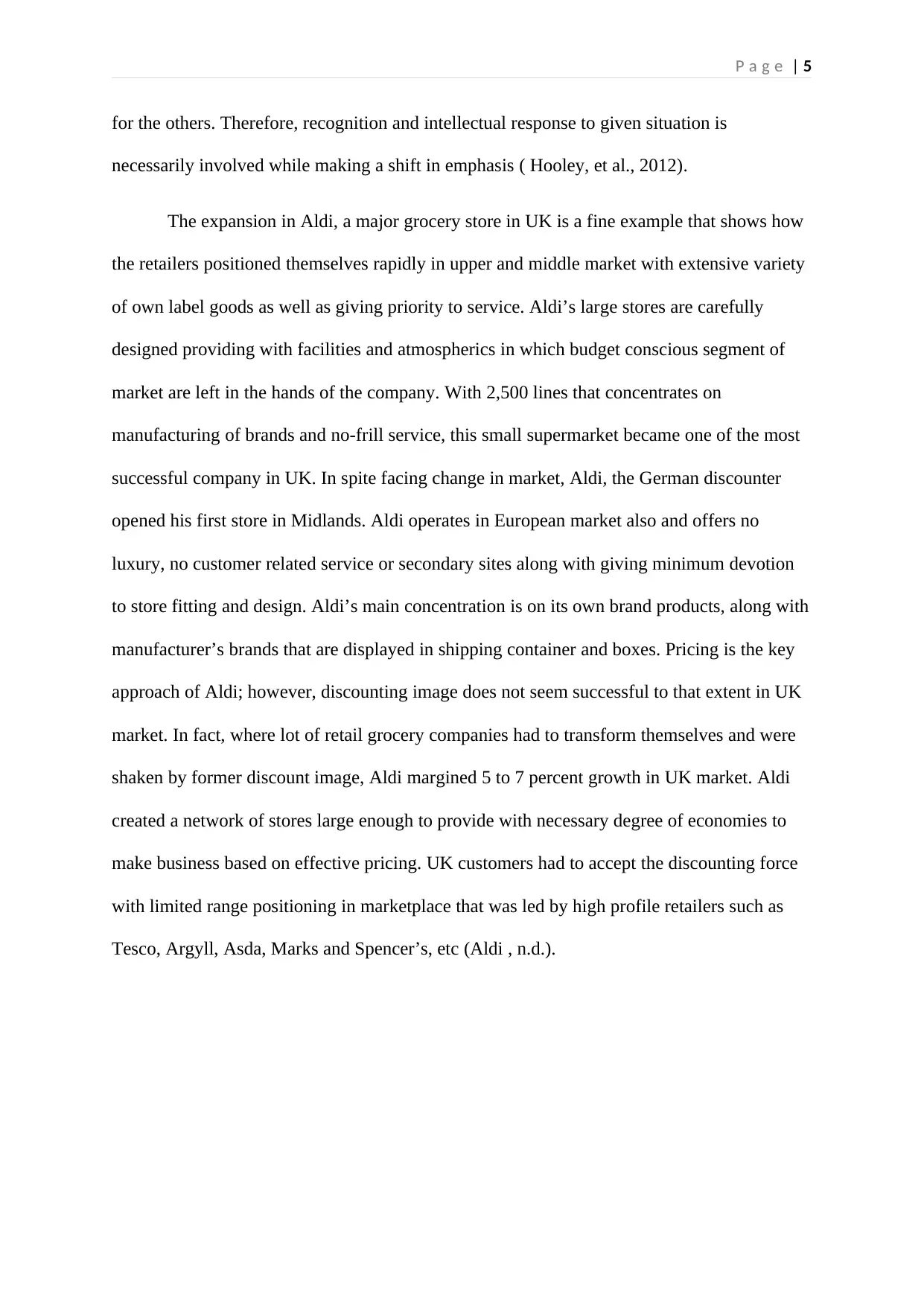
P a g e | 5
for the others. Therefore, recognition and intellectual response to given situation is
necessarily involved while making a shift in emphasis ( Hooley, et al., 2012).
The expansion in Aldi, a major grocery store in UK is a fine example that shows how
the retailers positioned themselves rapidly in upper and middle market with extensive variety
of own label goods as well as giving priority to service. Aldi’s large stores are carefully
designed providing with facilities and atmospherics in which budget conscious segment of
market are left in the hands of the company. With 2,500 lines that concentrates on
manufacturing of brands and no-frill service, this small supermarket became one of the most
successful company in UK. In spite facing change in market, Aldi, the German discounter
opened his first store in Midlands. Aldi operates in European market also and offers no
luxury, no customer related service or secondary sites along with giving minimum devotion
to store fitting and design. Aldi’s main concentration is on its own brand products, along with
manufacturer’s brands that are displayed in shipping container and boxes. Pricing is the key
approach of Aldi; however, discounting image does not seem successful to that extent in UK
market. In fact, where lot of retail grocery companies had to transform themselves and were
shaken by former discount image, Aldi margined 5 to 7 percent growth in UK market. Aldi
created a network of stores large enough to provide with necessary degree of economies to
make business based on effective pricing. UK customers had to accept the discounting force
with limited range positioning in marketplace that was led by high profile retailers such as
Tesco, Argyll, Asda, Marks and Spencer’s, etc (Aldi , n.d.).
for the others. Therefore, recognition and intellectual response to given situation is
necessarily involved while making a shift in emphasis ( Hooley, et al., 2012).
The expansion in Aldi, a major grocery store in UK is a fine example that shows how
the retailers positioned themselves rapidly in upper and middle market with extensive variety
of own label goods as well as giving priority to service. Aldi’s large stores are carefully
designed providing with facilities and atmospherics in which budget conscious segment of
market are left in the hands of the company. With 2,500 lines that concentrates on
manufacturing of brands and no-frill service, this small supermarket became one of the most
successful company in UK. In spite facing change in market, Aldi, the German discounter
opened his first store in Midlands. Aldi operates in European market also and offers no
luxury, no customer related service or secondary sites along with giving minimum devotion
to store fitting and design. Aldi’s main concentration is on its own brand products, along with
manufacturer’s brands that are displayed in shipping container and boxes. Pricing is the key
approach of Aldi; however, discounting image does not seem successful to that extent in UK
market. In fact, where lot of retail grocery companies had to transform themselves and were
shaken by former discount image, Aldi margined 5 to 7 percent growth in UK market. Aldi
created a network of stores large enough to provide with necessary degree of economies to
make business based on effective pricing. UK customers had to accept the discounting force
with limited range positioning in marketplace that was led by high profile retailers such as
Tesco, Argyll, Asda, Marks and Spencer’s, etc (Aldi , n.d.).
⊘ This is a preview!⊘
Do you want full access?
Subscribe today to unlock all pages.

Trusted by 1+ million students worldwide
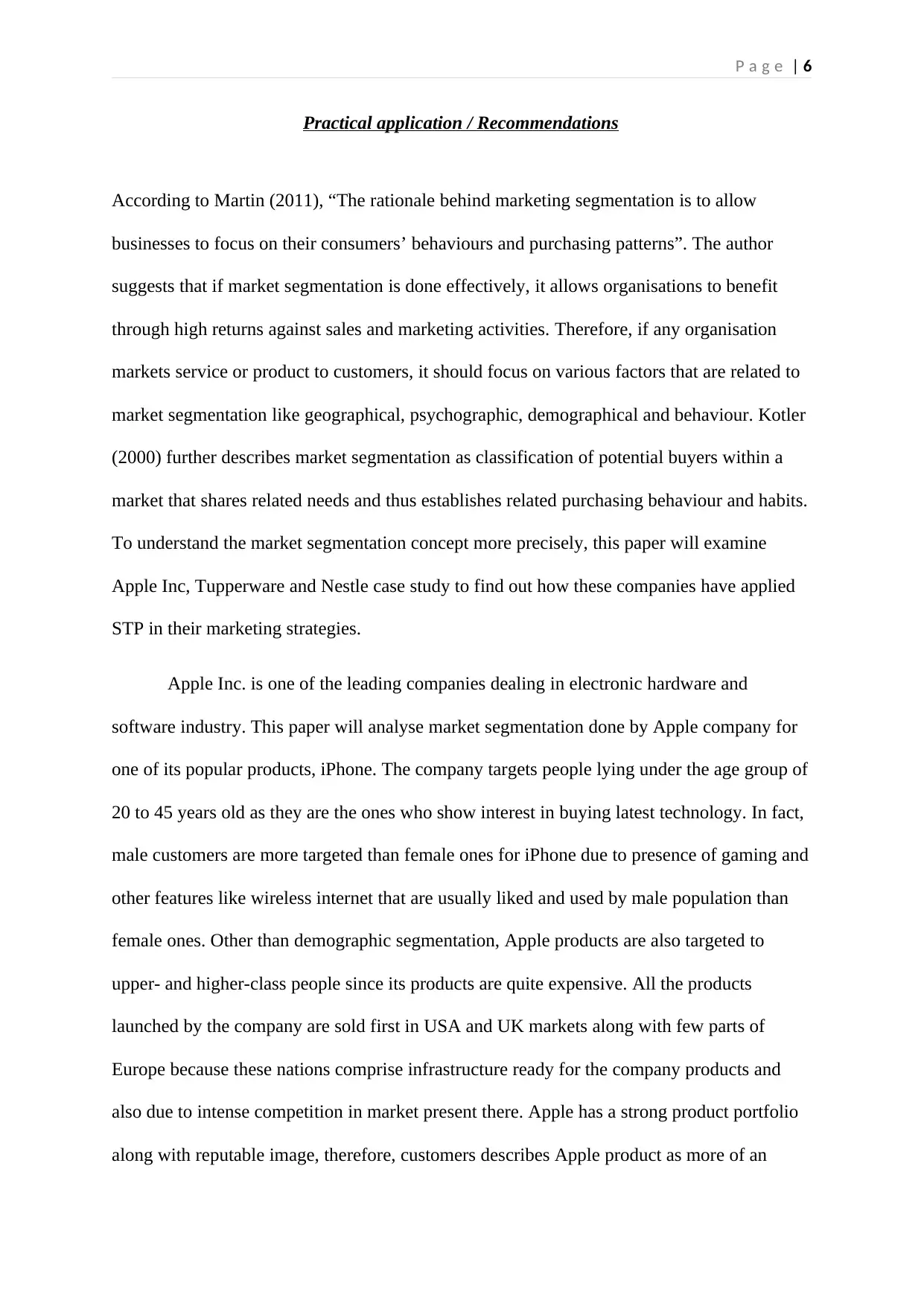
P a g e | 6
Practical application / Recommendations
According to Martin (2011), “The rationale behind marketing segmentation is to allow
businesses to focus on their consumers’ behaviours and purchasing patterns”. The author
suggests that if market segmentation is done effectively, it allows organisations to benefit
through high returns against sales and marketing activities. Therefore, if any organisation
markets service or product to customers, it should focus on various factors that are related to
market segmentation like geographical, psychographic, demographical and behaviour. Kotler
(2000) further describes market segmentation as classification of potential buyers within a
market that shares related needs and thus establishes related purchasing behaviour and habits.
To understand the market segmentation concept more precisely, this paper will examine
Apple Inc, Tupperware and Nestle case study to find out how these companies have applied
STP in their marketing strategies.
Apple Inc. is one of the leading companies dealing in electronic hardware and
software industry. This paper will analyse market segmentation done by Apple company for
one of its popular products, iPhone. The company targets people lying under the age group of
20 to 45 years old as they are the ones who show interest in buying latest technology. In fact,
male customers are more targeted than female ones for iPhone due to presence of gaming and
other features like wireless internet that are usually liked and used by male population than
female ones. Other than demographic segmentation, Apple products are also targeted to
upper- and higher-class people since its products are quite expensive. All the products
launched by the company are sold first in USA and UK markets along with few parts of
Europe because these nations comprise infrastructure ready for the company products and
also due to intense competition in market present there. Apple has a strong product portfolio
along with reputable image, therefore, customers describes Apple product as more of an
Practical application / Recommendations
According to Martin (2011), “The rationale behind marketing segmentation is to allow
businesses to focus on their consumers’ behaviours and purchasing patterns”. The author
suggests that if market segmentation is done effectively, it allows organisations to benefit
through high returns against sales and marketing activities. Therefore, if any organisation
markets service or product to customers, it should focus on various factors that are related to
market segmentation like geographical, psychographic, demographical and behaviour. Kotler
(2000) further describes market segmentation as classification of potential buyers within a
market that shares related needs and thus establishes related purchasing behaviour and habits.
To understand the market segmentation concept more precisely, this paper will examine
Apple Inc, Tupperware and Nestle case study to find out how these companies have applied
STP in their marketing strategies.
Apple Inc. is one of the leading companies dealing in electronic hardware and
software industry. This paper will analyse market segmentation done by Apple company for
one of its popular products, iPhone. The company targets people lying under the age group of
20 to 45 years old as they are the ones who show interest in buying latest technology. In fact,
male customers are more targeted than female ones for iPhone due to presence of gaming and
other features like wireless internet that are usually liked and used by male population than
female ones. Other than demographic segmentation, Apple products are also targeted to
upper- and higher-class people since its products are quite expensive. All the products
launched by the company are sold first in USA and UK markets along with few parts of
Europe because these nations comprise infrastructure ready for the company products and
also due to intense competition in market present there. Apple has a strong product portfolio
along with reputable image, therefore, customers describes Apple product as more of an
Paraphrase This Document
Need a fresh take? Get an instant paraphrase of this document with our AI Paraphraser
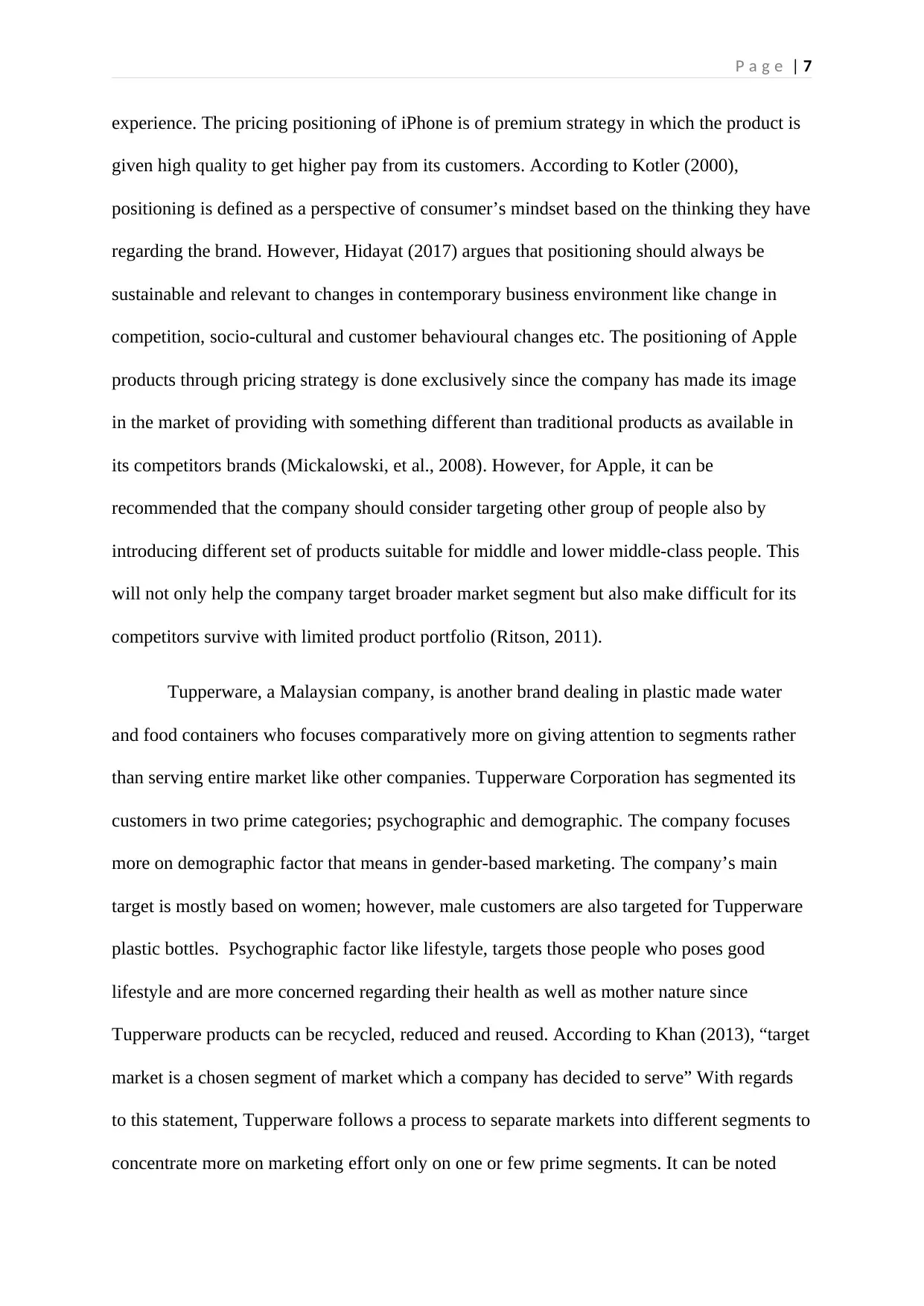
P a g e | 7
experience. The pricing positioning of iPhone is of premium strategy in which the product is
given high quality to get higher pay from its customers. According to Kotler (2000),
positioning is defined as a perspective of consumer’s mindset based on the thinking they have
regarding the brand. However, Hidayat (2017) argues that positioning should always be
sustainable and relevant to changes in contemporary business environment like change in
competition, socio-cultural and customer behavioural changes etc. The positioning of Apple
products through pricing strategy is done exclusively since the company has made its image
in the market of providing with something different than traditional products as available in
its competitors brands (Mickalowski, et al., 2008). However, for Apple, it can be
recommended that the company should consider targeting other group of people also by
introducing different set of products suitable for middle and lower middle-class people. This
will not only help the company target broader market segment but also make difficult for its
competitors survive with limited product portfolio (Ritson, 2011).
Tupperware, a Malaysian company, is another brand dealing in plastic made water
and food containers who focuses comparatively more on giving attention to segments rather
than serving entire market like other companies. Tupperware Corporation has segmented its
customers in two prime categories; psychographic and demographic. The company focuses
more on demographic factor that means in gender-based marketing. The company’s main
target is mostly based on women; however, male customers are also targeted for Tupperware
plastic bottles. Psychographic factor like lifestyle, targets those people who poses good
lifestyle and are more concerned regarding their health as well as mother nature since
Tupperware products can be recycled, reduced and reused. According to Khan (2013), “target
market is a chosen segment of market which a company has decided to serve” With regards
to this statement, Tupperware follows a process to separate markets into different segments to
concentrate more on marketing effort only on one or few prime segments. It can be noted
experience. The pricing positioning of iPhone is of premium strategy in which the product is
given high quality to get higher pay from its customers. According to Kotler (2000),
positioning is defined as a perspective of consumer’s mindset based on the thinking they have
regarding the brand. However, Hidayat (2017) argues that positioning should always be
sustainable and relevant to changes in contemporary business environment like change in
competition, socio-cultural and customer behavioural changes etc. The positioning of Apple
products through pricing strategy is done exclusively since the company has made its image
in the market of providing with something different than traditional products as available in
its competitors brands (Mickalowski, et al., 2008). However, for Apple, it can be
recommended that the company should consider targeting other group of people also by
introducing different set of products suitable for middle and lower middle-class people. This
will not only help the company target broader market segment but also make difficult for its
competitors survive with limited product portfolio (Ritson, 2011).
Tupperware, a Malaysian company, is another brand dealing in plastic made water
and food containers who focuses comparatively more on giving attention to segments rather
than serving entire market like other companies. Tupperware Corporation has segmented its
customers in two prime categories; psychographic and demographic. The company focuses
more on demographic factor that means in gender-based marketing. The company’s main
target is mostly based on women; however, male customers are also targeted for Tupperware
plastic bottles. Psychographic factor like lifestyle, targets those people who poses good
lifestyle and are more concerned regarding their health as well as mother nature since
Tupperware products can be recycled, reduced and reused. According to Khan (2013), “target
market is a chosen segment of market which a company has decided to serve” With regards
to this statement, Tupperware follows a process to separate markets into different segments to
concentrate more on marketing effort only on one or few prime segments. It can be noted
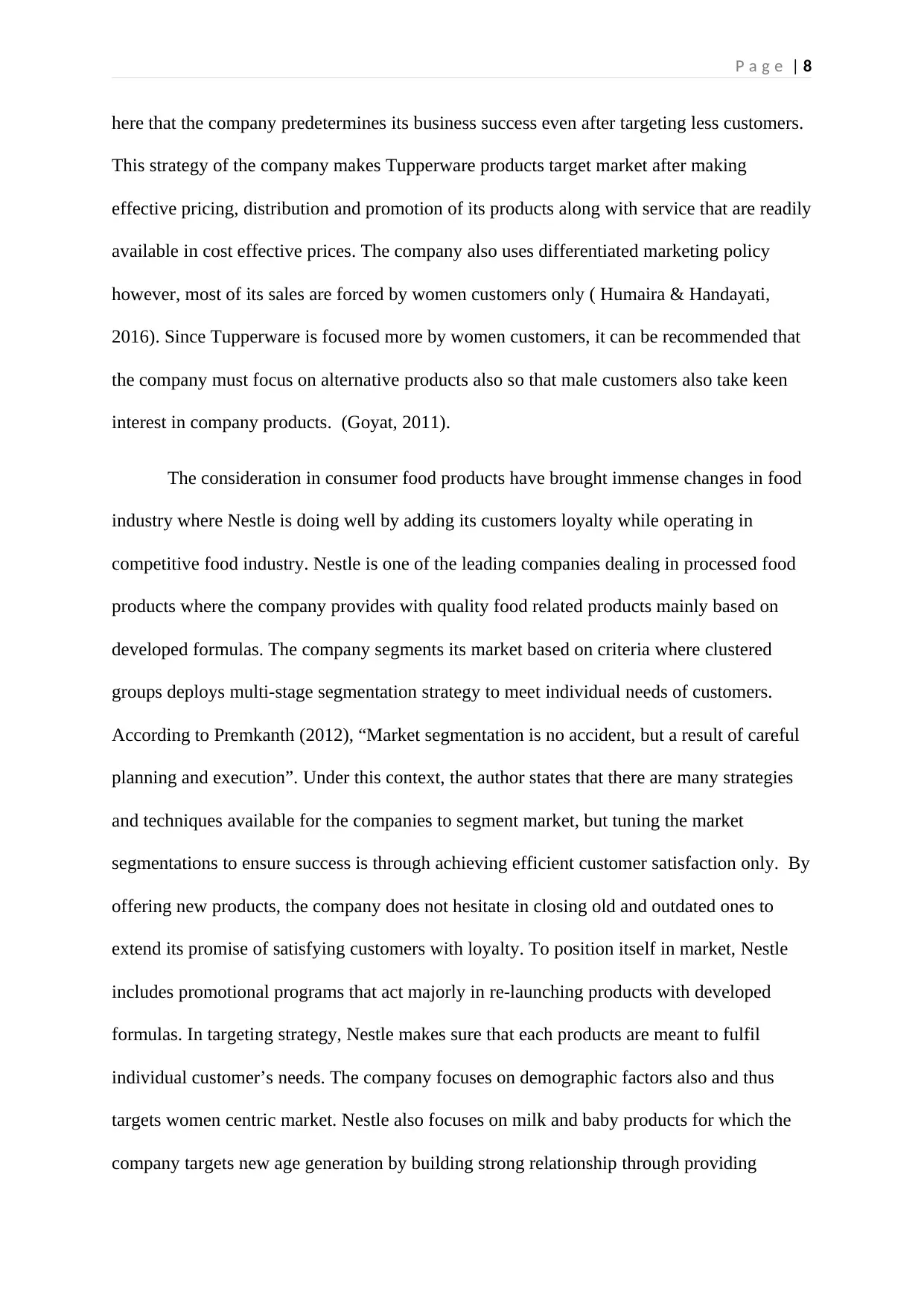
P a g e | 8
here that the company predetermines its business success even after targeting less customers.
This strategy of the company makes Tupperware products target market after making
effective pricing, distribution and promotion of its products along with service that are readily
available in cost effective prices. The company also uses differentiated marketing policy
however, most of its sales are forced by women customers only ( Humaira & Handayati,
2016). Since Tupperware is focused more by women customers, it can be recommended that
the company must focus on alternative products also so that male customers also take keen
interest in company products. (Goyat, 2011).
The consideration in consumer food products have brought immense changes in food
industry where Nestle is doing well by adding its customers loyalty while operating in
competitive food industry. Nestle is one of the leading companies dealing in processed food
products where the company provides with quality food related products mainly based on
developed formulas. The company segments its market based on criteria where clustered
groups deploys multi-stage segmentation strategy to meet individual needs of customers.
According to Premkanth (2012), “Market segmentation is no accident, but a result of careful
planning and execution”. Under this context, the author states that there are many strategies
and techniques available for the companies to segment market, but tuning the market
segmentations to ensure success is through achieving efficient customer satisfaction only. By
offering new products, the company does not hesitate in closing old and outdated ones to
extend its promise of satisfying customers with loyalty. To position itself in market, Nestle
includes promotional programs that act majorly in re-launching products with developed
formulas. In targeting strategy, Nestle makes sure that each products are meant to fulfil
individual customer’s needs. The company focuses on demographic factors also and thus
targets women centric market. Nestle also focuses on milk and baby products for which the
company targets new age generation by building strong relationship through providing
here that the company predetermines its business success even after targeting less customers.
This strategy of the company makes Tupperware products target market after making
effective pricing, distribution and promotion of its products along with service that are readily
available in cost effective prices. The company also uses differentiated marketing policy
however, most of its sales are forced by women customers only ( Humaira & Handayati,
2016). Since Tupperware is focused more by women customers, it can be recommended that
the company must focus on alternative products also so that male customers also take keen
interest in company products. (Goyat, 2011).
The consideration in consumer food products have brought immense changes in food
industry where Nestle is doing well by adding its customers loyalty while operating in
competitive food industry. Nestle is one of the leading companies dealing in processed food
products where the company provides with quality food related products mainly based on
developed formulas. The company segments its market based on criteria where clustered
groups deploys multi-stage segmentation strategy to meet individual needs of customers.
According to Premkanth (2012), “Market segmentation is no accident, but a result of careful
planning and execution”. Under this context, the author states that there are many strategies
and techniques available for the companies to segment market, but tuning the market
segmentations to ensure success is through achieving efficient customer satisfaction only. By
offering new products, the company does not hesitate in closing old and outdated ones to
extend its promise of satisfying customers with loyalty. To position itself in market, Nestle
includes promotional programs that act majorly in re-launching products with developed
formulas. In targeting strategy, Nestle makes sure that each products are meant to fulfil
individual customer’s needs. The company focuses on demographic factors also and thus
targets women centric market. Nestle also focuses on milk and baby products for which the
company targets new age generation by building strong relationship through providing
⊘ This is a preview!⊘
Do you want full access?
Subscribe today to unlock all pages.

Trusted by 1+ million students worldwide
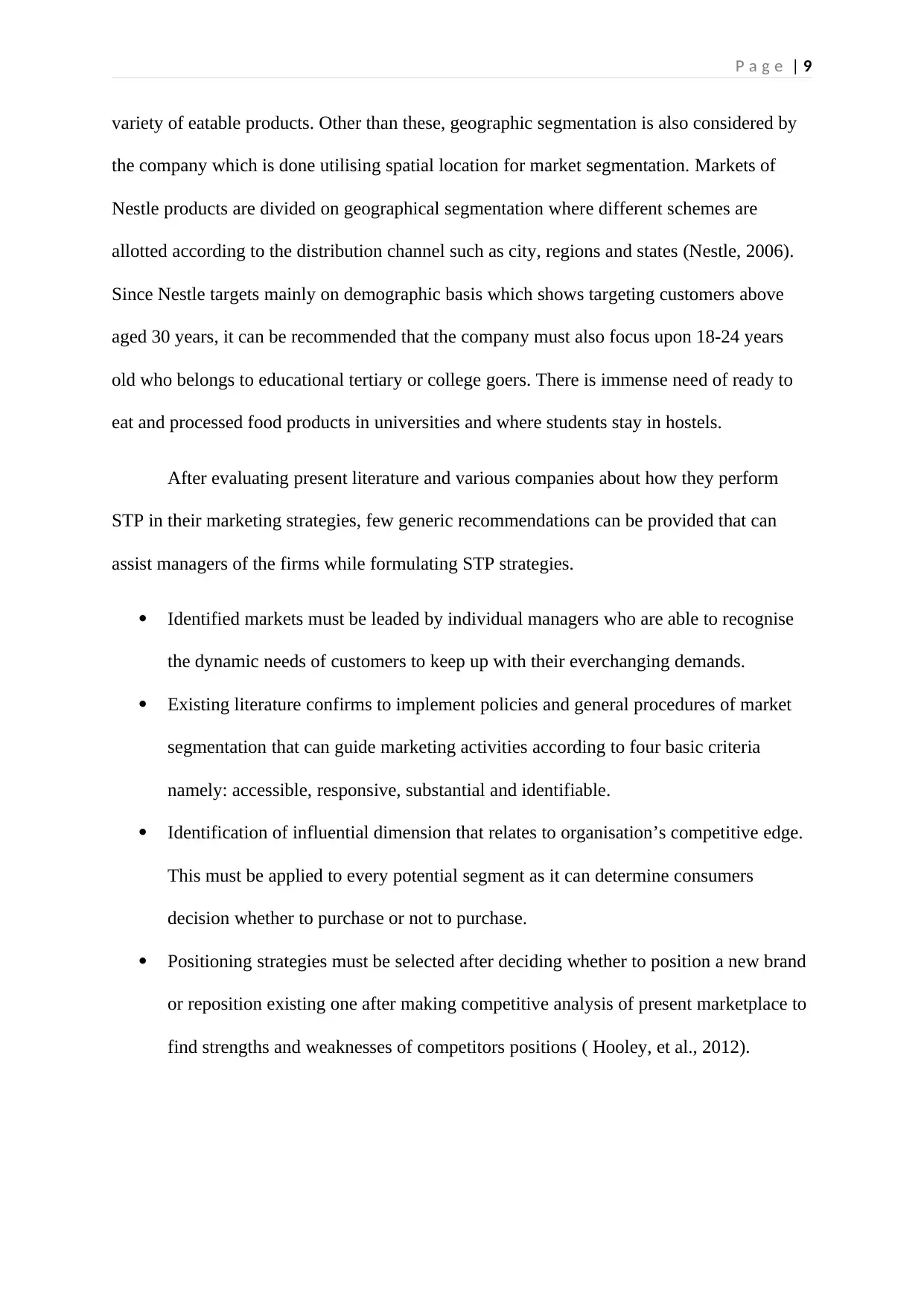
P a g e | 9
variety of eatable products. Other than these, geographic segmentation is also considered by
the company which is done utilising spatial location for market segmentation. Markets of
Nestle products are divided on geographical segmentation where different schemes are
allotted according to the distribution channel such as city, regions and states (Nestle, 2006).
Since Nestle targets mainly on demographic basis which shows targeting customers above
aged 30 years, it can be recommended that the company must also focus upon 18-24 years
old who belongs to educational tertiary or college goers. There is immense need of ready to
eat and processed food products in universities and where students stay in hostels.
After evaluating present literature and various companies about how they perform
STP in their marketing strategies, few generic recommendations can be provided that can
assist managers of the firms while formulating STP strategies.
Identified markets must be leaded by individual managers who are able to recognise
the dynamic needs of customers to keep up with their everchanging demands.
Existing literature confirms to implement policies and general procedures of market
segmentation that can guide marketing activities according to four basic criteria
namely: accessible, responsive, substantial and identifiable.
Identification of influential dimension that relates to organisation’s competitive edge.
This must be applied to every potential segment as it can determine consumers
decision whether to purchase or not to purchase.
Positioning strategies must be selected after deciding whether to position a new brand
or reposition existing one after making competitive analysis of present marketplace to
find strengths and weaknesses of competitors positions ( Hooley, et al., 2012).
variety of eatable products. Other than these, geographic segmentation is also considered by
the company which is done utilising spatial location for market segmentation. Markets of
Nestle products are divided on geographical segmentation where different schemes are
allotted according to the distribution channel such as city, regions and states (Nestle, 2006).
Since Nestle targets mainly on demographic basis which shows targeting customers above
aged 30 years, it can be recommended that the company must also focus upon 18-24 years
old who belongs to educational tertiary or college goers. There is immense need of ready to
eat and processed food products in universities and where students stay in hostels.
After evaluating present literature and various companies about how they perform
STP in their marketing strategies, few generic recommendations can be provided that can
assist managers of the firms while formulating STP strategies.
Identified markets must be leaded by individual managers who are able to recognise
the dynamic needs of customers to keep up with their everchanging demands.
Existing literature confirms to implement policies and general procedures of market
segmentation that can guide marketing activities according to four basic criteria
namely: accessible, responsive, substantial and identifiable.
Identification of influential dimension that relates to organisation’s competitive edge.
This must be applied to every potential segment as it can determine consumers
decision whether to purchase or not to purchase.
Positioning strategies must be selected after deciding whether to position a new brand
or reposition existing one after making competitive analysis of present marketplace to
find strengths and weaknesses of competitors positions ( Hooley, et al., 2012).
Paraphrase This Document
Need a fresh take? Get an instant paraphrase of this document with our AI Paraphraser
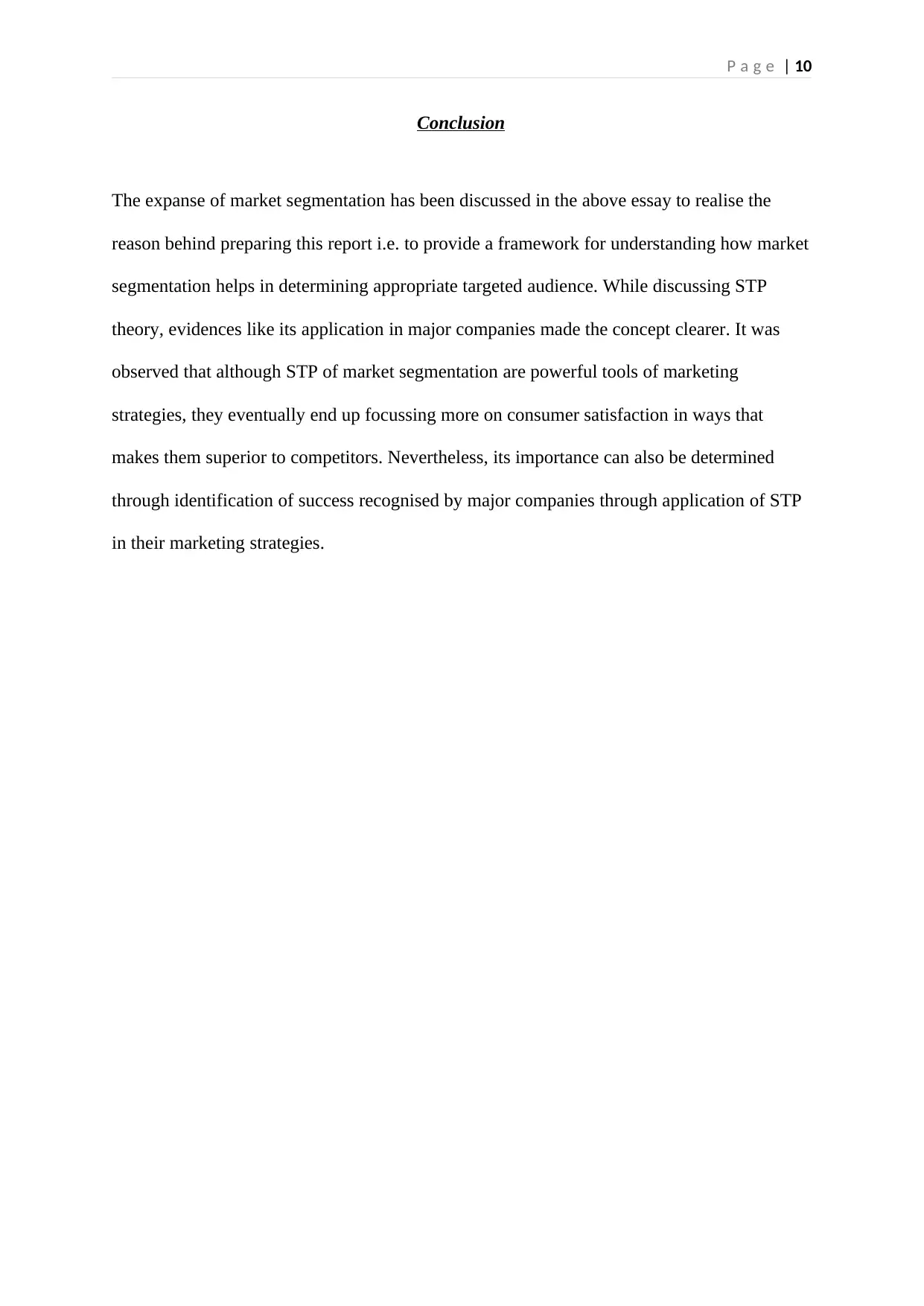
P a g e | 10
Conclusion
The expanse of market segmentation has been discussed in the above essay to realise the
reason behind preparing this report i.e. to provide a framework for understanding how market
segmentation helps in determining appropriate targeted audience. While discussing STP
theory, evidences like its application in major companies made the concept clearer. It was
observed that although STP of market segmentation are powerful tools of marketing
strategies, they eventually end up focussing more on consumer satisfaction in ways that
makes them superior to competitors. Nevertheless, its importance can also be determined
through identification of success recognised by major companies through application of STP
in their marketing strategies.
Conclusion
The expanse of market segmentation has been discussed in the above essay to realise the
reason behind preparing this report i.e. to provide a framework for understanding how market
segmentation helps in determining appropriate targeted audience. While discussing STP
theory, evidences like its application in major companies made the concept clearer. It was
observed that although STP of market segmentation are powerful tools of marketing
strategies, they eventually end up focussing more on consumer satisfaction in ways that
makes them superior to competitors. Nevertheless, its importance can also be determined
through identification of success recognised by major companies through application of STP
in their marketing strategies.
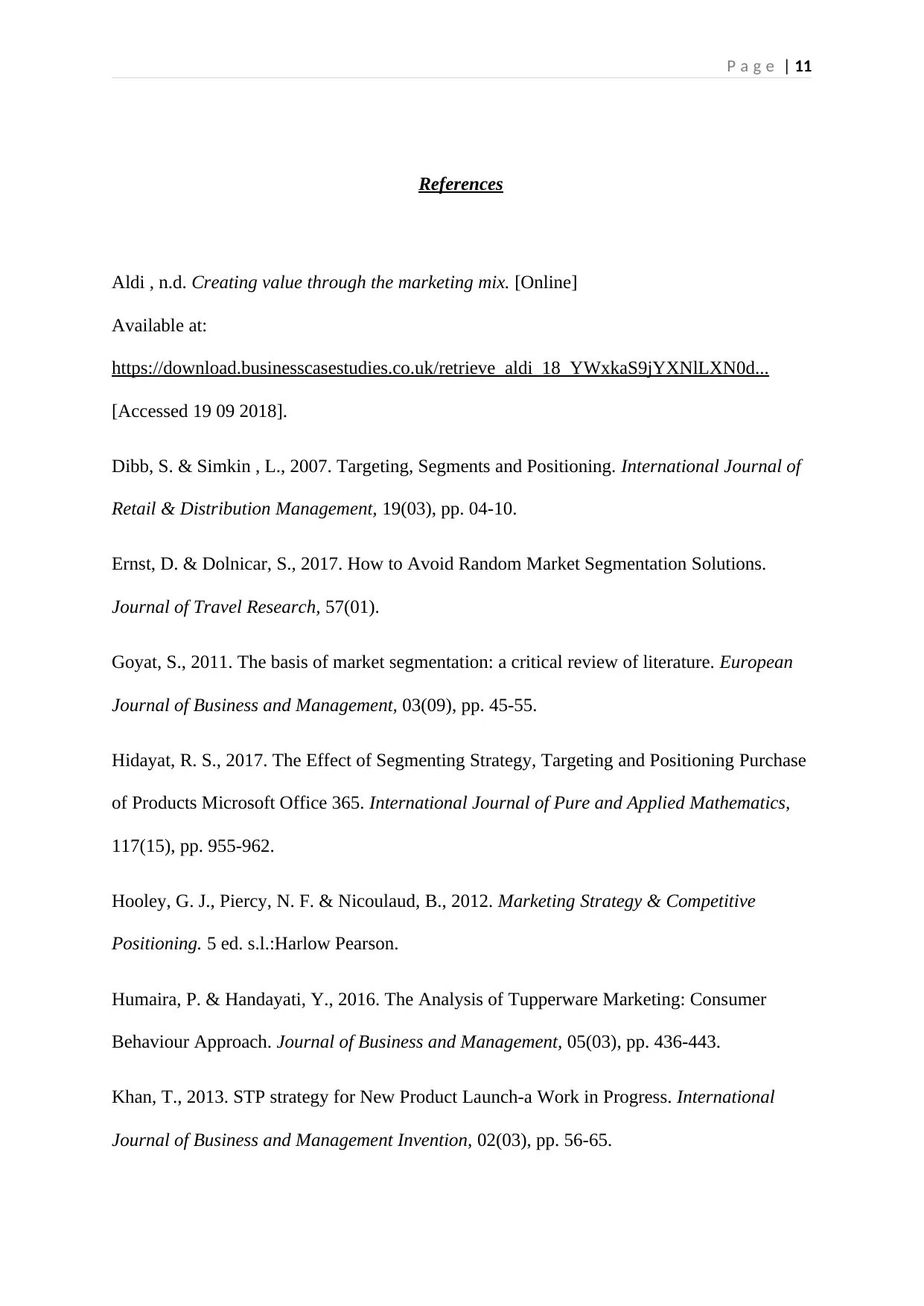
P a g e | 11
References
Aldi , n.d. Creating value through the marketing mix. [Online]
Available at:
https://download.businesscasestudies.co.uk/retrieve_aldi_18_YWxkaS9jYXNlLXN0d...
[Accessed 19 09 2018].
Dibb, S. & Simkin , L., 2007. Targeting, Segments and Positioning. International Journal of
Retail & Distribution Management, 19(03), pp. 04-10.
Ernst, D. & Dolnicar, S., 2017. How to Avoid Random Market Segmentation Solutions.
Journal of Travel Research, 57(01).
Goyat, S., 2011. The basis of market segmentation: a critical review of literature. European
Journal of Business and Management, 03(09), pp. 45-55.
Hidayat, R. S., 2017. The Effect of Segmenting Strategy, Targeting and Positioning Purchase
of Products Microsoft Office 365. International Journal of Pure and Applied Mathematics,
117(15), pp. 955-962.
Hooley, G. J., Piercy, N. F. & Nicoulaud, B., 2012. Marketing Strategy & Competitive
Positioning. 5 ed. s.l.:Harlow Pearson.
Humaira, P. & Handayati, Y., 2016. The Analysis of Tupperware Marketing: Consumer
Behaviour Approach. Journal of Business and Management, 05(03), pp. 436-443.
Khan, T., 2013. STP strategy for New Product Launch-a Work in Progress. International
Journal of Business and Management Invention, 02(03), pp. 56-65.
References
Aldi , n.d. Creating value through the marketing mix. [Online]
Available at:
https://download.businesscasestudies.co.uk/retrieve_aldi_18_YWxkaS9jYXNlLXN0d...
[Accessed 19 09 2018].
Dibb, S. & Simkin , L., 2007. Targeting, Segments and Positioning. International Journal of
Retail & Distribution Management, 19(03), pp. 04-10.
Ernst, D. & Dolnicar, S., 2017. How to Avoid Random Market Segmentation Solutions.
Journal of Travel Research, 57(01).
Goyat, S., 2011. The basis of market segmentation: a critical review of literature. European
Journal of Business and Management, 03(09), pp. 45-55.
Hidayat, R. S., 2017. The Effect of Segmenting Strategy, Targeting and Positioning Purchase
of Products Microsoft Office 365. International Journal of Pure and Applied Mathematics,
117(15), pp. 955-962.
Hooley, G. J., Piercy, N. F. & Nicoulaud, B., 2012. Marketing Strategy & Competitive
Positioning. 5 ed. s.l.:Harlow Pearson.
Humaira, P. & Handayati, Y., 2016. The Analysis of Tupperware Marketing: Consumer
Behaviour Approach. Journal of Business and Management, 05(03), pp. 436-443.
Khan, T., 2013. STP strategy for New Product Launch-a Work in Progress. International
Journal of Business and Management Invention, 02(03), pp. 56-65.
⊘ This is a preview!⊘
Do you want full access?
Subscribe today to unlock all pages.

Trusted by 1+ million students worldwide
1 out of 13
Related Documents
Your All-in-One AI-Powered Toolkit for Academic Success.
+13062052269
info@desklib.com
Available 24*7 on WhatsApp / Email
![[object Object]](/_next/static/media/star-bottom.7253800d.svg)
Unlock your academic potential
Copyright © 2020–2025 A2Z Services. All Rights Reserved. Developed and managed by ZUCOL.





